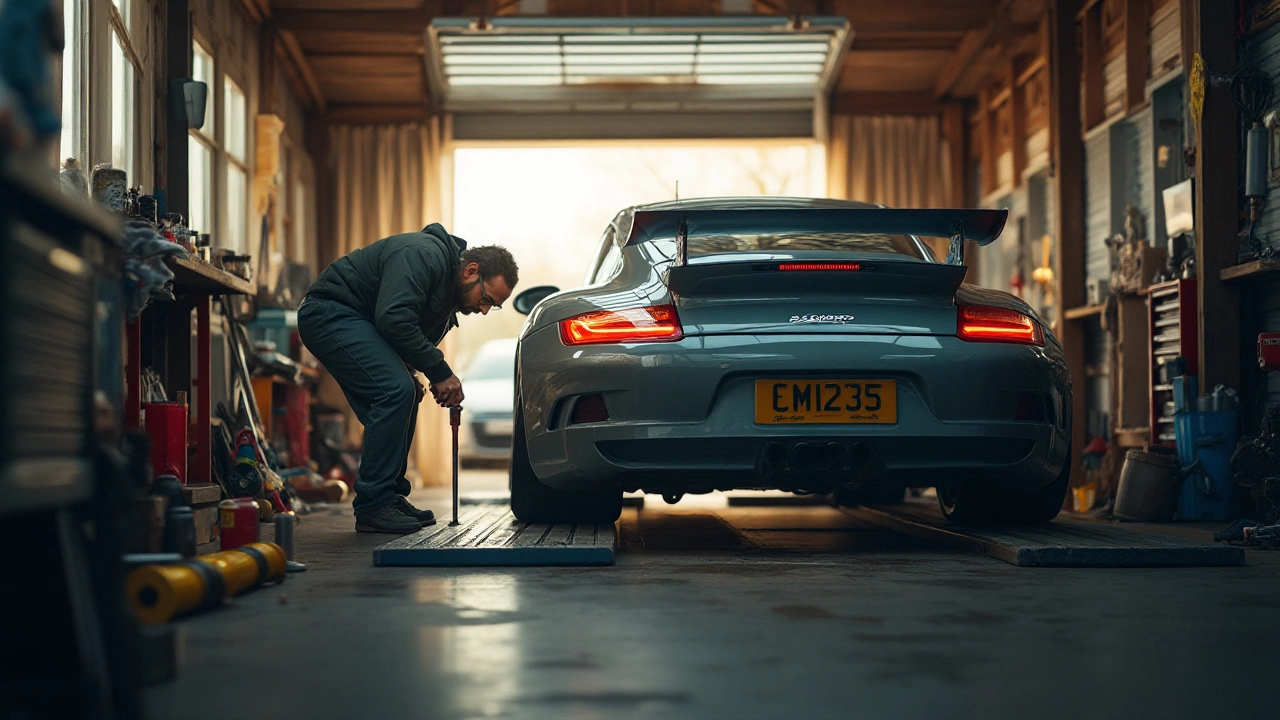Thinking about giving your car a fresh new look paired with improved handling? You might want to consider coilovers. Coilovers aren't just about style; they provide car enthusiasts with a dynamic solution for adjusting ride height while enhancing the car's overall performance.
With the ability to tweak various suspension settings, coilovers offer a combination of flexibility and performance tweaks. It's not just about making your car look cool on the road; it's about precision handling and a more connected driving experience.
But with great customization comes a few challenges. Getting the installation right is crucial to reaping all the benefits while avoiding any issues down the line. Join us as we explore how coilovers can be the tool you need to lower your car and take your ride's performance to the next level.
- Understanding Coilovers and How They Work
- Benefits of Lowering Your Car with Coilovers
- Tips for Installing Coilovers Effectively
- Key Considerations Before Installing Coilovers
- Potential Drawbacks and Maintenance
Understanding Coilovers and How They Work
To truly grasp the concept of coilovers and the impact they can have on your vehicle, one must first understand their function and composition. Coilovers, in essence, are a combination of a coil spring that encircles a shock absorber. They aren't just ordinary springs; they are designed to give a more flexible adjustment to the ride height and the car’s handling response. With coilovers, drivers have the ability to adjust how far their vehicle sits from the ground, which directly influences both the aesthetics and performance of the car. As you might imagine, this adjustment can make a significant difference in cornering performance by keeping the car tighter to the pavement.
There are two types of coilovers commonly discussed among gearheads: full coilovers and slip-on coilovers. Full coilovers are a complete unit, offering an easy bolt-on installation process, effectively replacing the current suspension system. Slip-on versions, meanwhile, are designed to fit over existing shock absorbers. While the latter might sound like a cost-effective alternative, they often don't provide the same range of adjustment or performance benefits. A key advantage of coilovers over traditional lowering springs is their adjustable nature. According to a suspension expert from Automotive Engineering magazine, “
Coilovers provide a tailored driving experience, allowing adjustments that cater to both the track enthusiast and the daily commuter.”
The mechanics of how coilovers work extends beyond simple adjustments. At the core, they offer control over the spring preload, the damping settings, and the ride height. By using adjusters, one can alter the preload of the spring, thus changing how the coil reacts to driving conditions. Damping adjustments, typically found on more advanced models, allow the driver to calibrate how firm or soft the ride feels, perfect for adapting to different road conditions or driving styles. It's crucial to note that incorrect setup can lead to degraded vehicle performance. A comprehensive manual and sometimes professional guidance are often necessary for a successful setup.
When we delve into the technical side, some enthusiasts may encounter the term 'damping force customization'. Simply put, this allows a driver to fine-tune how quickly the suspension compresses and rebounds, significantly affecting grip and handling. Contrary to popular belief, not compromising comfort is possible with the right settings, making coilovers not only appealing for the track but also for everyday use. An interesting study conducted by Car Performance Journal highlighted that cars equipped with well-adjusted coilovers had a 7% improvement in handling precision as opposed to traditional suspension setups.
Finally, investing time in learning about the different types of coilovers can prevent future headaches and ensure an optimal driving experience. Enthusiasts often favor brands that offer robust warranty and support, pointing to a well-regarded industry practice. Aftermarket options abound, and understanding the exact specifications and compatibilities with your car model is paramount. Remember, the world of coilovers extends beyond the mere technical aspects—it's about customizing your ride to fit your driving style and preferences, potentially transforming your driving experience altogether.
Benefits of Lowering Your Car with Coilovers
Lowering a vehicle using coilovers is more than just about achieving an aesthetic appeal. It offers tangible improvements in your ride's performance and handling dynamics. This suspension modification has steadily gained popularity among car enthusiasts for its ability to deliver enhanced grip, cornering capability, and a more aggressive stance. By reducing the car's center of gravity, you pave the way for a thrilling driving experience that is marked by improved stability and minimized body roll. This translates into more confidence while maneuvering corners, as the tires maintain a tighter grip on the road. Additionally, the adjustable nature of coilovers allows drivers to dial in the perfect balance between stiffness and comfort, tailoring the suspension to suit specific driving styles or conditions. Those who hit the track on weekends will love how coilovers accommodate quick tweaks to suspension settings, optimizing performance for each unique circuit.
Another advantage stems from the customizable aspect of coilovers. With the simple twist of a wrench, drivers can adjust ride height, making it convenient to strike the right balance between street legality and track readiness. This might explain why so many car enthusiasts champion the flexibility that comes with coilovers, enabling them to experiment with various setups until they find their sweet spot. Also, employment of quality coilover kits often results in improved shock absorption over bumps and dips—an important feature for those navigating less-than-perfect road conditions. Since coilovers integrate the spring and shock absorber into a single assembly, they tend to be a more efficient and compact solution compared to traditional lowering springs.
"In the sports car community, coilovers stand out not for what they take away in terms of height, but what they add to the driving experience," explains Alex Hunter, a renowned motorsports engineer.Cost may initially appear as a downside due to coilovers being generally more expensive than simple springs. However, for many, the benefits far outweigh the investment, given coilovers' durability and the precise handling improvements they provide. Plus, the knowledge that you can achieve the desired look and performance gives peace of mind that is hard to quantify. With coilovers, drivers don't have to settle; they can have their ride look and handle just as desired.
It's important to note, as with any car modification, the quality of the product and proper installation are crucial. Sending your vehicle into a professional setup can ensure that everything aligns as planned—avoiding potential handling and safety issues down the line. It's always wise to tap into the experiences of others or seek professional guidance when adjusting to new suspension settings, ensuring that every adjustment enhances the vehicle's performance safely and effectively. Investing in coilovers isn't merely about a single change; it's about embracing a realm of possibilities that enhance the way you experience your vehicle. By thinking through each adjustment, you open the door to a distinctly rewarding connection between driver and road.

Tips for Installing Coilovers Effectively
Installing coilovers is a rewarding endeavor that can dramatically change how you experience your drive, but it’s crucial to approach the task with precision and care. Before diving into the installation process, make sure you have all necessary tools on hand. A well-equipped toolkit is essential, including socket wrenches, hex keys, a jack, and jack stands, alongside any specific tools recommended by the coilover manufacturer. Start by safely elevating the vehicle to a comfortable working height using the jack stands, ensuring that it's stable and secure to avoid any accidents during the process.
The next step involves removing the existing suspension components. Carefully detach the strut assemblies starting from the hardware connecting them to the control arm, then move to the bolts at the top of the strut tower. Retain any small parts like bolts or washers, as missing pieces can stall progress. Once the old suspension is out, it’s time to install the coilovers. Often, coilover kits include adjustable components; make use of these to fit your car's specific strut tower dimensions. Line up the coilover base with the appropriate mounting points, making sure everything stays aligned to facilitate the process.
Adjusting the ride height must be handled thoughtfully. Some car enthusiasts suggest beginning with a conservative height to maintain drivability; you can always dial it in later. Use the threaded body to align the coilover spring rates to your desired specification. A useful trick is to secure the lower locking collar using an allen wrench to prevent future slippage. Repeat the process for all corners of the vehicle, always verifying alignment multiple times. After setting the coilovers in place, it’s time for a thorough check—make sure all bolts and nuts are properly torqued according to specification.
Once everything appears in place, consider consulting with a professional for a wheel alignment. “Proper alignment after installing coilovers is key to keeping your drive smooth and your tires wearing evenly,” suggests John Miller, a veteran automotive technician.
“A thorough wheel alignment ensures that your vehicle handles safely and performs to its full potential,” Miller shares.Professional alignment adjusts the car's camber, caster, and toe settings post-installation, helping maintain optimal contact between the tires and the road. To maintain the performance benefits, schedule routine checks to ensure everything remains as it should be, as adjustments can shift over time due to various road conditions and driving habits.
For those who love data, testing suspension changes can be insightful. Document metrics such as cornering speed, braking distance, or even minutes around your favorite track before and after lowering your car. There are aftermarket kits equipped with sensors that can help quantify these changes, turning subjective comfort into valuable data-driven insights.
Installations can often be invigorating, introducing a new layer of performance and aesthetics to the car. However, it is essential to recognize that learning and hands-on experiences are part of the process. Don't hesitate to ask fellow car enthusiasts for tips or share insights within car communities—after all, the sense of achievement and community is a huge part of what makes car modification a riveting hobby and lifestyle.
Key Considerations Before Installing Coilovers
Before diving into the world of coilovers, there are several key factors that any car enthusiast should consider. First and foremost, you need to determine your primary purpose for installing them. Are you aiming for a better-looking stance, or is performance enhancement your top priority? These goals will guide you in selecting the right kind of coilovers suited to your needs. Keep in mind that not all coilovers are created equal; some are designed with street use in mind while others cater to track conditions. This distinction can affect everything from the cost of the setup to the flexibility it offers in terms of adjustments.
Budget might be one of the most crucial considerations. Coilovers can range from a couple of hundred dollars to several thousands, depending on the brand and advanced features. Investing in high-quality, well-reviewed coilovers can save you the hassle of frequent adjustments and potential part failures. Delve into user reviews and expert opinions to ensure you're getting reliable gear. You might come across advice like,
"Performance and reliability are more crucial than saving a few bucks. A cheaper setup can cost you more in the long run with frequent repairs and replacements," - AutoPhile Magazine, which emphasizes quality over frugality.
Another crucial point is the compatibility of the coilovers with your car make and model. Not every coilover setup will fit every vehicle perfectly. It's essential to verify that the ones you plan to buy are compatible with your car's suspension system. This step can involve researching mounting points and ensuring that no additional components are needed. Invest time in understanding whether your vehicle may also require upgraded suspension parts such as strut mounts or control arms to accommodate the new setup.
Once you have narrowed down your options, think about who will perform the installation. While it is possible to install coilovers yourself if you have the right skills and tools, professional installation might be worthwhile. A reputable auto shop can ensure not only that the installation is done correctly but also that the coilovers are adjusted to offer the optimal balance between ride height and performance. They can also deal with any unforeseen issues that might crop up during the process.
Finally, maintenance cannot be overlooked when you think about upgrading to coilovers. Unlike standard shocks and springs that require minimal intervention, coilovers need periodic checks and adjustments to maintain peak performance. They are sensitive to dirt, grime, and moisture, which can lead to corrosion if not properly managed. Regular cleaning and occasional lubrication can extend their lifespan significantly. A maintenance schedule, similar to how you treat your engine and transmission, should be in place to maximize both functionality and longevity of the system.

Potential Drawbacks and Maintenance
Diving into the world of coilovers comes with its set of challenges and upkeep. For starters, adjusting ride height with coilovers can be a meticulous task. Unlike standard suspension setups, coilovers are engineered with customization in mind, allowing drivers to adjust height, damping, and even spring preload. However, this adjustability means any miscalibration can lead to uneven tire wear or compromised handling. It’s essential to make adjustments carefully, preferably with the help of a professional, to ensure the suspension is dialed in for optimal performance.
There is also the matter of ride comfort. Lowering a vehicle inevitably reduces the space in the suspension travel, which can lead to a harsher ride. Roads with imperfections, speed bumps, and driveways can become more challenging as the vehicle bottom-out risk increases. For those who daily their modified ride, this can be a notable concern, as the trade-off between handling precision and comfort levels might not always be in their favor.
Maintenance is another area where coilovers require keen attention. Since these components are part of a car’s active suspension, they face constant wear and tear. Owners should regularly inspect them for signs of rust, wear, or damage on the springs and dampers. It’s also advisable to clean the threads of adjustable components to prevent them from seizing due to dirt and road grime accumulation. Regular maintenance not only prolongs the life of coilovers but also ensures the ride remains smooth and safe.
Installation done without proper care can amplify these drawbacks. Poor installation can mislead the car’s alignment, causing the vehicle to pull in one direction or affecting cornering capabilities. Therefore, a professional installation is often recommended to avoid these potential pitfalls. When it comes to tackling rough terrains, it's wise to keep in mind that while coilovers enhance vehicle agility and response, their setup must be robust enough to manage the rigors of uneven surfaces.
According to an engineer's perspective from a notable car tuning workshop, "The beauty and burden of coilovers lie in their infinite adjustability; a little finesse can go a long way, and when done right, the driving experience becomes something extraordinary."
| Aspect | Recommendation |
|---|---|
| Regular Checkups | Every 10,000 miles |
| Thread Cleaning | Every 6 months |
| Alignment | After major height adjustments |
In summary, while coilovers offer significant benefits in terms of ride customization and performance benefits, they enfold potential drawbacks that require proactive attention. By understanding these intricacies, drivers can enjoy prime benefits while ensuring their vehicle remains both stylish and safe.




